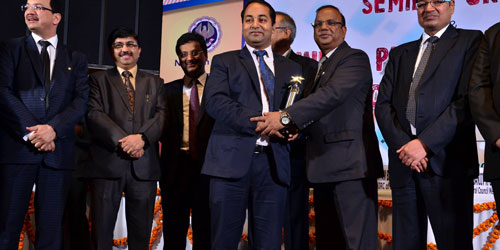
Introduction
Located in the southern peninsula of the Asian continent, India is the seventh largest and second most populous country in the world with a total land area of about 3.3 million square kilometers and a population of approximately 1.13 billion. The Indian sub-continent is distinct from the rest of Asia. In the North are the towering Himalayas, which slope out into the great Indo-Gangetic plains. In Central India, the Vindhya ranges separate the Deccan peninsula from the northern plains. On the east coast of the country projects into the Indian ocean. The Republic of India is divided into 28 federative states (divided on linguistic basis) and seven centrally administered union territories.
India possesses richness and diversity of culture and climatic conditions and natural and mineral resources. A new spirit of economic freedom is stirring in India. Today, India is said to be the third largest economy (in terms of purchase power parity) in the world. A series of ambitions economic reforms have deregulated the economy and stimulated domestic and foreign investment. The liberalization program has unleashed the vast potential of Indian economy. India’s enduring institutions, which are rooted in the principles of democracy, ensure a transparent, predictable and secure environment for foreign investment. The existence of a free and vibrant press, an independent judiciary, a strong legal and accounting system and the use of English as the principal language of business and administration are some of the attractive features of the business environment.
India’s official language is Hindi in the Devanagri script. While English enjoys associate status, it is widely spoken and is one of the most important languages for national, political and commercial communication. The states are, however, free to decide their own regional languages. There are 24 principal languages spoken in India. As the birthplace of four major religions that exist even today, India is rightfully known as the land of spirituality and philosophy. The most dominant religion in India today is Hinduism with almost 82% of the people being Hindus and 12.12% are Muslim. Other large religious groups include Christians 2.34%, Sikhs 1.94%, Buddhists 0.76%, Jains 0.40%, other religions and persuasions 0.39% and religions not stated 0.05%.
India possesses an abundance of qualified and skilled manpower, which makes it an ideal base for sourcing production, both for export and the huge domestic market. The private sector is the backbone of the economy, accounting for 75% of the GDP. The opening up of the economy, which has resulted in the entry of a large number of foreign companies, together with the increasingly global focus of domestic industry, has resulted in the dynamic growth and increased competitiveness of Indian firms. The role and importance of the private sector in India’s economic development is rapidly increasing. Today, India is one of the most exciting emerging markets in the world.
Organization of Government
India has a parliamentary form of government similar to the English model. The central legislature, i.e. the parliament, is bicameral. It consists of Rajya Sabha (Council of States), which is the upper house, and Lok Sabha, which is the lower house. Members of the Lok Sabha are directly elected by way of adult franchise for a period of five years; whereas election to the Rajya Sabha is indirect, that is, the representatives are not elected through adult franchise by the people. The president and vice-president of India are elected indirectly by a separate electoral college; each holding office for a term of five years. The President, as head of the executive invites the leader of the party commanding parliamentary majority to form the government.
The Prime Minister and the cabinet are responsible to the Lok Sabha. The president acts in accordance with the advice of the Council of Ministers. Substantial executive powers therefore rest with the Prime Minister. All legislation must receive the assent of both case of a financial legislation. The constitutionality of legislation and executive acts can be questioned before the courts. The executive makes regulations when a statute requires regulations to be passed for its implementation and administration.
The Following Areas are State Monopolies:
- World's largest democracy with 1.2 billion people.
- Stable political environment and responsive administrative set up.
- Well established judiciary to enforce rule of law.
- Land of abundant natural resources and diverse climatic conditions.
- India's growth will start to outpace China's within three to five years and hence will become the fastest large economy with 9-10 per cent growth over the next 20-25 years (Morgan Stanley).
- Investor friendly policies and incentive based schemes.
- India's economy will grow fivefold in the next 20 years (McKinsey).
- Cost competitiveness; low labour costs.
- Total labour force of nearly 530 million.
- Large pool of skilled manpower; strong knowledge base with significant English speaking population.
- Young country with a median age of 30 years by 2025: India's economy will benefit from this "demographic dividend". \
- The proportion of population in the working age group (15-59 years) is likely to increase from approximately 58 per cent in 2001 to more than 64 per cent by 2021.
- Compliance with WTO norms.
- Robust banking and financial institutions.
- Production of atomic energy.
- production, etc, of minerals specified in the Schedule to the Atomic Energy (Control of production and Use) Order 1953;
- Railway transport.
- Huge untapped market potential.
- The urban population of India will double from the 2001 census figure of 290 m to approximately 590 m by 2030 (McKinsey).
- Goldman Sachs predicts Indian economy to be the third largest in the world by 2050.
- The world's third largest investor base only after U.S.A and Japan.
- Progressive simplification and rationalization of direct and indirect tax structures.
- Reduction in import tariffs.
- Full current account convertibility.
- However, the government is now permitting select private sector investment in the mining and defence industry.
- Large presence of FIIs in the Indian capital market with over 451 FIIs and 38 foreign brokers registered with SEBI.
- Placed amongst the most transparent & mature markets in the world.
"* India's financial year is from April to March. 2010-11 above means April 2010-March 2011."
Knowledge Professionals in India
India's natural resource lie in its abundant technically skilled manpower. India is the world's second largest exporter of software (after the U.S.), and is the source of management and technical talent for over 40 per cent of new start-ups in Silicon Valley. Thanks to its large English-speaking scientific and higher education institutions, specialist computer institutes, and low costs of software talent, India has more software companies with ISO 9000 certification than any other country in the world.
There is more than enough evidence of the superlative role that Indians play in the progress of the Net. The impact of India's success abroad is also being felt. The stars of the Indian Internet industry are the Web solutions and Webware companies, many of whom have made the transition from offshore turnkey and services companies to full-fledged e-commerce service providers and Web strategy consultants. IT heavyweights like Microsoft, Intel, Cisco and Compaq always feature India prominently in their itineraries.
According to the National Association of Software & Service Companies, the Indian software industry lobby, almost half the Fortune 500 companies now use Indian Software services. With over 4 million highly trained English speaking technical personnel (second only to the USA), heavy government support and leading world class software companies, India is set to become the software giant of the new Millennium. Furthermore, a World Bank funded study in the United States confirmed that vendors rated India as their number one choice for outsourcing. Other industry sectors have benefited greatly from their decision to outsource to India: The U.S. and India have an average 12-hour time zone difference, but this kind of use of datacom can provide a virtual 24-hour office to a client in the U.S. Lately, this concept has worked wonders for large projects and also for projects involving remote software maintenance using video conferencing. Offshore projects mean immense time and cost savings.
Benefits of Outsourcing in India
- India offers many advantages that make it the favorite of 82 percent of US software export market (Nasscom).
- Large pool of computer literate and English speaking professionals
- Well recognized Information technology skills
- Wide gap between personnel costs in India and developed countries.
- Quality standards meet the approval of the world. India exports software to more than 95 countries.
- India has a stable political environment and pro-IT government.
- Work practices largely comply with ISO and SEI CMM standards. Three out of every four SEI-CMM 5 companies worldwide are located in India.
- Reliable satellite and submarine communication links facilitate good broadband connectivity with the rest of the world.
- A large, expansive and established network of academic infrastructure - According to data released by the Department of Secondary and Higher Education, Ministry of Human Resource Development, and Government of India
- A favourable demographic profile - The underlying factor highlighting India's long-term attractiveness is its highly favourable demographic profile. With nearly 60 per cent of its population between the ages 15-59, and more than half below the age of 25. In contrast, countries including the US, Europe, Japan and China have a more aged population with dependency ratios likely to increase over the same period.
- Nearly 2.3 million other graduates and over 300,000 post-graduates each year.
- At the end of March 2005 there were 343 institutes of higher education in India and 16,000 colleges with a total enrollment of 9.3million, producing 441,000 technical graduates.
Also, with English being a widely accepted medium of instruction in the Indian education system, a large proportion of the graduate pool is proficient in English. By all standards, India's future looks bright. It has banished famine and cut absolute poverty by more than half. Its economic growth is among the fastest of any country. Figures published show annual GDP growth over the past three years has averaged 8.1%.
India is fast becoming the “outsourcing destination of choice” of the world in sectors such as Information Technology, Pharmaceuticals, Banking and Finance, Insurance, Gem and Jewellery, Manufacturing etc. This is mainly due to the ample availability of competent and cost efficient workforce whereby setting up operations in India has become synonymous to efficient and cost effective operations. The growing Indian middle class population has placed India as “The market of the future”. As a result of these factors, many of the leading companies all over the world have already set up operations in India or are planning to do so.







